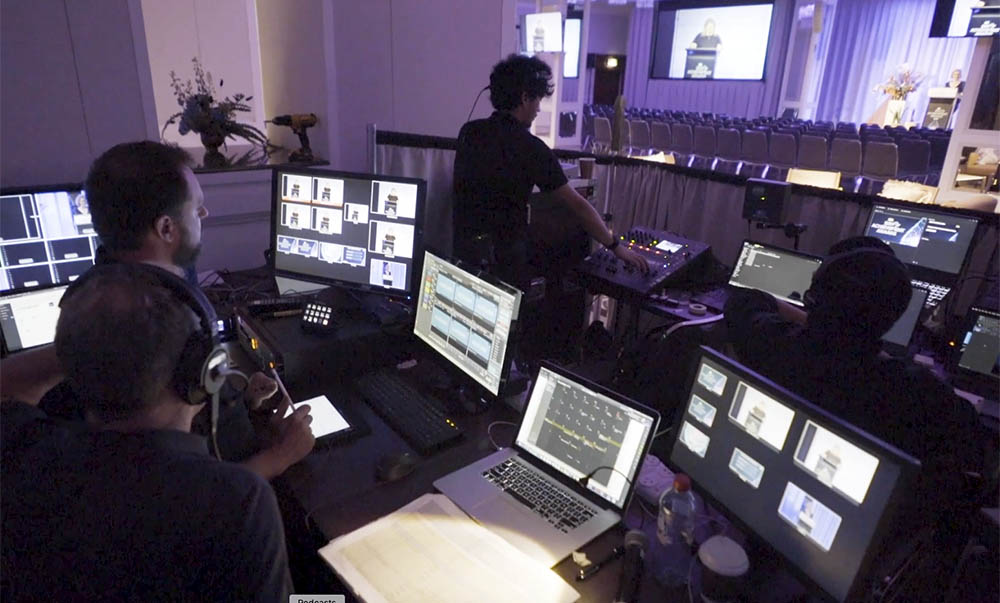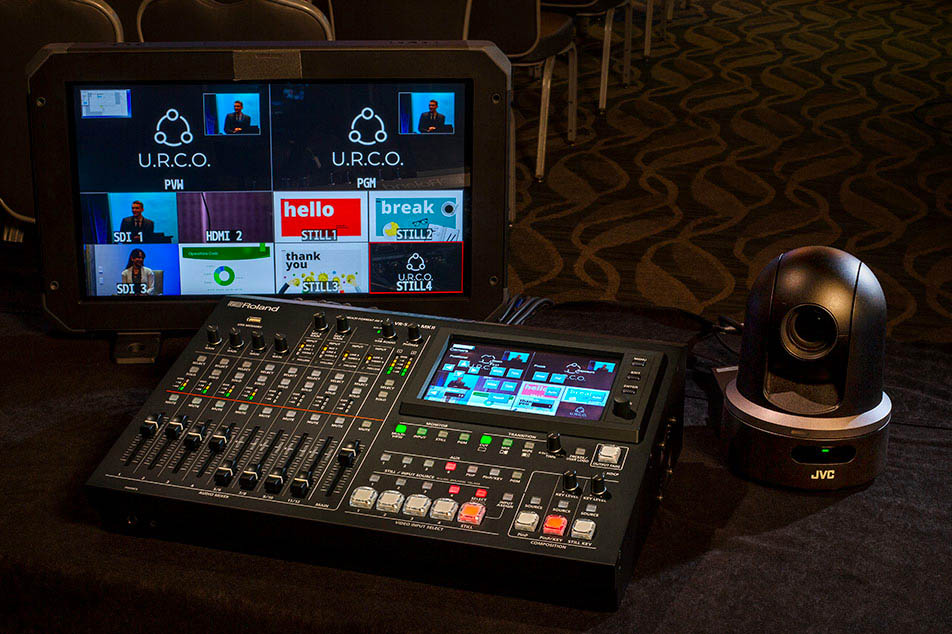It’s no secret that AV production companies and event spaces had a few tough years in 2020/21. With worldwide travel restrictions and limits on the number of people allowed to attend events, businesses resorted to virtual gatherings via platforms such as YouTube Live and Zoom.
Interestingly, as we move towards reopening, many of the lessons learned seem to be here to stay. For instance, most of us are questioning the need to work from the office five days a week! Another thing that’s changed is the need to add a streaming component to live events, so much so that it now has its own name – the Hybrid Event.
What is a hybrid event?
A Hybrid event is an event catering to both in-person and virtual attendees. With the correct planning and technology, both audiences can have a great experience.
Advantages of Hybrid Events (promoter)
- Larger (potential) audience
- Smaller venues required
- Reduced catering
- Access to live online polling/questionnaires
- Offer both offline & online resources
Advantages of Hybrid Events (virtual attendees)
- Attend/View speakers at a suitable time
- No travel/accommodation costs
- Access to online resources, Q&A
- Extra access to keynote speakers (potentially)
Challenges of Hybrid Events (promoter)
- Maintaining engagement of virtual audience
- Additional technology required (cameras/streaming etc.)
- Managing scheduling of in-person and online presentations
Challenges of Hybrid Events (virtual attendees)
- Lack of in-person networking
- Lack of excitement compared to live event
The Need to Stream…
Most event spaces and A/V production companies have had to rethink their strategies for attracting/retaining business. With the increase in hybrid events, live streaming is now expected by customers as a standard inclusion. Unfortunately, most customers don’t appreciate the complexities this adds to a production.
The live stream often needs to be quite different to the in-house presentation. Inclusions such as picture-in-picture of the presenter when showing slides, lower-third titles, branding, sweeping crowd shots etc. are all important for the online audience.
Choosing the right vision mixer for Hybrid Events
An interview with Myles AV at The Sydney Intercontinental Hotel
Marc Allen, from Roland ProAV, recently visited Lee Sparke and Lorenzo Guevarra, from Myles AV at the Sydney Intercontinental Hotel. They discussed what live events are looking like so far this year.
Marc: Hi Lee and Lorenzo. Thanks for your time. To begin, what type of clients and events do you cater for here at Intercontinental Hotel?
Lee: We do a varied amount of events, anything from dinners, breakfasts, conferences and our clientele are very diverse from government bodies, non-for-profit organisations, and of course lots of functions for the corporate sector.
Marc: How have the bookings for events been?
Lee: Things are really picking up. Like everyone in the event space, we had a quiet year in 2020 but over the past few months, the bookings have steadily increased. The hardest thing is probably getting people to commit to a date ahead of time. Most of us have experienced the last-minute changing of travel conditions and reduced numbers allowed at gatherings over the past year. I can understand the hesitancy in the market to organise large events.
Hybrid Events - the need to stream

The A/V Control Room at the Intercontinental Hotel, Sydney
Marc: Have you noticed many changes in client’s requests?
Lee: Definitely. There is a big demand now for live streaming the events. We used to get the occasional streaming request but now we are asked all the time. It’s funny really, the person booking will often say they want to book a Hybrid Event. It seems that phrase has become known by our clients as an event that has both attendees and a live streaming component.
Marc: Do your clients understand what is involved in streaming an event?
Lee: Some do. Unfortunately, there are a lot of people who think it is as simple as pointing a phone at the event and pressing the ‘go live’ button. In reality, we usually have to explain that it involves a lot more than that to get multiple camera angles, videos, slides, and great audio out as a stream.
Marc: So Lorenzo, how have you found streaming from the VR-50HD MKii?
Lorenzo: It’s great. It’s become really common for clients to make last-minute live streaming requests, which isn’t ideal, but thankfully for us, with the VR-50 and the VR-1, it’s no problem at all, we can stream right out of the units.
Marc: You also mentioned the VR-1HD. What other Roland gear does Myles AV currently use?
Lorenzo: We have two V-800s, 4 VR-50s, and a VR-1 in regular rotation around all of our locations in Sydney.
Favourite features of the VR-50HD MKii
Marc: Do you have any favourite features on the VR-50HD MKii?
Lorenzo: I do, it has some great features, like a big colour touch screen, clean audio preamps, great compositing, and of course, it is able to stream or record without any extra fuss. Another great thing is the ability to handle last-minute requests from clients. The VR-50 can handle pretty much any source, even old laptops, and phones. It has come through for us again and again.
Marc: How have your techs found learning the MKii?
Lee: One of the things that drew us to it was the fact that it was incredibly user-friendly and all of our techs, contractors and full-time staff managed to get their head around it really quickly.
Not everyone knows how to use every piece of equipment, but once they’ve used something similar, whether it be the V-800 or a VR-50 vision mixer, you can operate any model in a few minutes. So, and that’s really useful to us.
Lorenzo: Being hardware-based helps too.
Marc: Lee, how is the return on investment with the V-50HD MKii?
Lee: When we are buying a vision mixer, or any equipment really, we always look to see how much they are and what sort of return on investment we’ll get, and although the VR-50 isn’t the cheapest on the market it certainly packs a punch and gives a massive return of investment. This is mainly because it’s so useful and we know that we are going to have it for at least five, ten years … or until there’s a MKiii available!
Marc: On that note, we’ll leave you to your preparation for tonight’s event. Thanks for your time.

